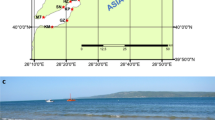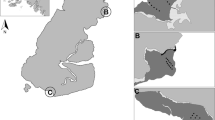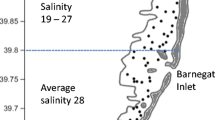Abstract
A 1979 study of the macrobenthos of Ross Barnett Reservoir, Mississippi, identified 20 genera of invertebrates. Benthic invertebrate productivity ranged from 1.45 g m−2 yr−1 in profundal zones to 5.07 g m−2 yr−1 in littoral zones with major contributors including Hexagenia bilineata, Chaoborus punctipennis, Chironomus attenuatus, Tanypus stellatus and Coelotanypus tricolor. Numerical and species variation were influenced by depth zones, factors associated with reservoir age (17 years), and sediment and vegetative development in the reservoir benthic zones. Littoral productivity, although limited by lack of zone development, was greater than that of flood control reservoirs in the south central United States because of water level stability. Profundal productivity was limited by hypolimnional oxygen stress. Benthos was a major food source of freshwater drum (Aplodinotus grunniens) which forms a significant portion of the reservoir fisheries.
Similar content being viewed by others
References
Ball, R. C., 1948. Relationship between available fish food, feeding habits of fish, and total fish production in a Michigan lake. Mich. St. College Ag. Exp. Stat. Tech. Bull. 206: 1–59.
Cooper, C. M., 1977. Abundance and production of littoral and profundal benthic fauna in a flood control reservoir. Proc. Miss. Chap. am. Fish. Soc. 1: 25–33.
Cooper, C. M., 1980. Benthic productivity in Mississippi lakes and reservoirs as compared with that of northern lakes. Proc. Miss. Chap. am. Fish. Soc. 4: 9–17.
Cooper, C. M., 1981. A population study of the Diptera (Insecta) of Grenada Reservoir, Mississippi. J. Freshwater Ecol. 1: 251–265.
Lenat, D. R., D. L. Penrose and K. W. Eagleson, 1981. Variable effects of sediment addition on stream benthos. Hydrobiologia 79: 187–194.
McLachlan, A. J. & S. M. McLachlan, 1971. Benthic fauna and sediments in the newly created Lake Kariba (Central Africa). Ecology 62: 801–809.
Miller, R. B., 1941. A contribution to the ecology of the Chironomidae of Costello Lake, Algonguin Park, Ontario. Univ. Toronto Studies, Biol. Serv. 49: 1–6.
Swedberg, D. W., 1968. Food and growth of the freshwater drum in Lewis and Clark Lake, South Dakota. Trans. am. Fish. Soc. 97: 442–447.
Sublette, J. E., 1957. The ecology of the macroscopic bottom fauna in Lake Texoma (Denison Reservoir), Oklahoma and Texas. Am. Midl. Nat. 57: 371–402.
Waters, T. F., 1977. Secondary production in inland waters. Adv. ecol. Res. 10: 91–164.
Wetzel, R. G., 1975. Limnology. W. B. Saunders Company, Philadelphia, PA.: 525.
Author information
Authors and Affiliations
Rights and permissions
About this article
Cite this article
Cooper, C.M., Knight, L.A. Macrobenthos-sediment relationships in Ross Barnett Reservoir, Mississippi. Hydrobiologia 126, 193–197 (1985). https://doi.org/10.1007/BF00007496
Received:
Revised:
Accepted:
Issue Date:
DOI: https://doi.org/10.1007/BF00007496




